
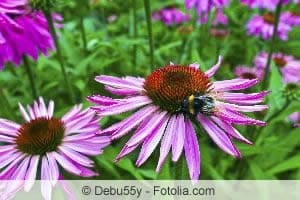
Table of contents
- Floor
- Fertilize
- Cut
- hibernate
- use
- frequently asked Questions
- Worth knowing about the red coneflower shortly
The plant is a permanent bloomer and offers the flower lover, therefore, a long-lasting ornament. The plant can be easily combined with other perennials and even herbs and grasses. The different varieties, which bring a variety of colors to the garden landscape, are also popular. Colors such as white, pink and other color nuances can complete the picture here. Generous garden areas offer the plant the opportunity to develop its wild character, which it owes to its origin. In addition to being cultivated as an ornamental plant, Echinacea purpurea is also known for its valuable properties as a medicinal plant. The healing effect of the plant is used for colds and to strengthen the immune system.
Floor
The red coneflower can be found wild in light forests. In the open air and in garden borders, the plant prefers well-drained and nutrient-rich soil. The soil around the plant may be loosened from time to time so that it remains permeable for watering. The soil should not be too dry to provide the plant with a suitable environment. The perennial plant can reach a height of 80 to 160 cm. The plant should not be exposed to too much shade so that the flower image can fully unfold its well-known splendor.
Fertilize
Compost is an ideal fertilizer for the plant. In spring and autumn, the robust plant is happy about an addition of compost around the perennial. Thus, the red coneflower is supplied with sufficient additional nutrients, so that the addition of commercial fertilizers is hardly necessary.
Cut
When should purple coneflowers be cut back to have a long time of the plant? Every 3 or 4 years after the flowering period, it is worth pruning the plant back to 10 cm above ground level. So that it can continue to develop its full flowering power in nutrient-rich soil, the plant can be cut back after pruning separated from the old soil with a spade and lifted in order to be used again at another suitable place become. In general, discretionary removal of faded parts of the plant is useful to allow new blooms to grow back quickly. The red coneflower has a relatively late budding.
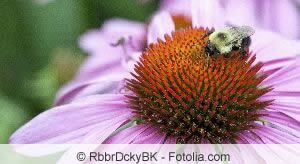
hibernate
The frost hardy plant is very robust and easy to handle even in cold temperatures. A layer of mulch provides additional protection for the hardy plant.
use
Although the red coneflower is mainly known as a medicinal plant, it is also very popular as an ornamental plant and even as a cut flower. As a remedy, the purple coneflower is primarily characterized by its immune system-strengthening effect. In addition, the purple coneflower is said to have an antiseptic and antibiotic effect and activate the scavenger cells in the blood, which then destroy the pathogenic bacteria. It is used in many different medicines and is a particularly good remedy for the onset of a cold. In addition to being used as a medicine for colds, the pressed juice or the dried herb of the red coneflower can be helpful for respiratory and urinary tract infections.
Furthermore, it can be used externally for injuries, ulcers and inflammation of the skin. The fresh juice of the plant from the flowering and above-ground parts is processed into a medicine. But also dried plant parts above ground or the roots are processed into a natural remedy. Anyone who suffers from an infectious disease or their immune system in the case of flu, cold, inflammation of the respiratory tract or If you want to increase gland swelling, you can use a tincture, coneflower honey or mixed resistance drops take in. These remedies also help as preventive measures to increase the immune system.
For external use, poultices with a diluted tincture are used or a few drops of Echinacea tincture applied directly to the wounds. You can also give children Echinacea for internal use without further ado.
Tip:
However, it is important to ensure that the tincture is prepared without alcohol. For children there are special mixtures enriched with sweet honey.
frequently asked Questions
Plants with a half-height habit that do not crowd the perennial are well suited in the vicinity of the red coneflower.
Basically, waterlogging should be avoided when watering the purple coneflower.
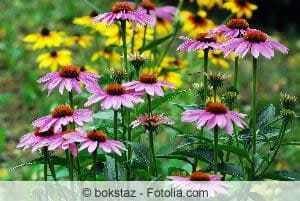
Worth knowing about the red coneflower shortly
- The purple coneflower is native to North America, but is now cultivated worldwide as a medicinal and ornamental plant.
- In the wild, this plant can be found in sparse forests, in nutrient-rich, well-drained soil in a sunny location.
- The red coneflower is a perennial plant that can grow between 80 and 160 cm.
- What is striking about this plant are the flowers, which are very similar to marguerites. The flowers can reach a diameter of up to 14 cm.
- The typical flowering period for the red coneflower is from June to September.
- The ideal location for planting coneflowers is in full sun.
- The plant prefers a nutrient-rich, permeable and humus-rich soil and should be fertilized in spring and late summer.
- Otherwise, the red coneflower is considered to be very frugal and easy to care for.
- Withered leaves of the purple coneflower should be cut off. So there is a possibility that new petals will form very quickly.
- In autumn, the entire plant is cut back to the ground. A layer of mulch then protects it from the freezing temperatures in winter, even if the red coneflower is hardy.
- In the spring you can multiply the red coneflower by the method of division. This should be done every three to four years for existing plants.
- As an alternative to division, propagation can also be done by sowing.
- It is also possible to cut root cuttings.
- The individual plants should be planted at a distance of approx. 40 cm to each other.
- In the spring it should be ensured that the red sugar loaf is well protected from snails.
 garden editorial
garden editorial I write about everything that interests me in my garden.
Find out more about perennial lexicon

Lenten rose, Helleborus orientalis: 13 tips for care
The spring rose is one of the few plants that also blooms in winter. In order for the plant to bear its colorful flowers, however, certain requirements regarding location and care must be met.
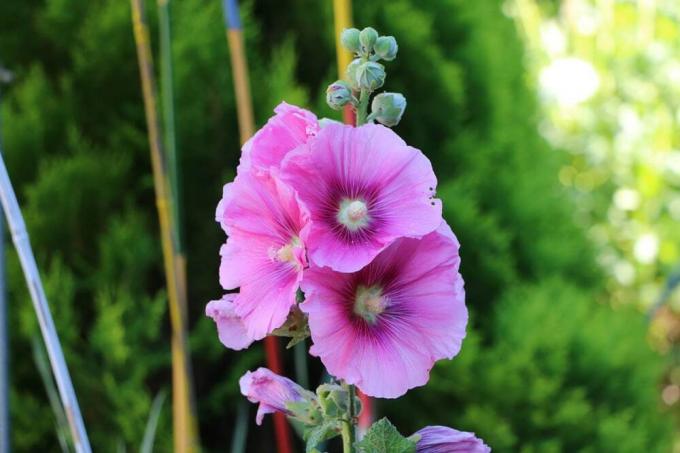
13 hardy perennials for sunny locations
Hardy perennials have a particularly long lifespan and allow sunny locations to bloom beautifully. At the beginning of each season, the perennial plants thrive anew and enchant the garden with a colorful world of flowers. Due to the large number of varieties, you have many design options.

Tree peony, Paeonia suffruticosa: Care from A - Z
With its large, eye-catching and colorful flowers, it is one of the noblest representatives of the peonies, the tree peony. Its natural home is China, which is why it is often referred to as the imperial flower. It presents its beautiful flowers between April and June.

Fat man: Care from A-Z | Planting distance and propagation
The shady areas under trees are neglected in many gardens, because only a few plants feel comfortable here. One of these few plants is the fat man (bot. Pachysander terminalis).
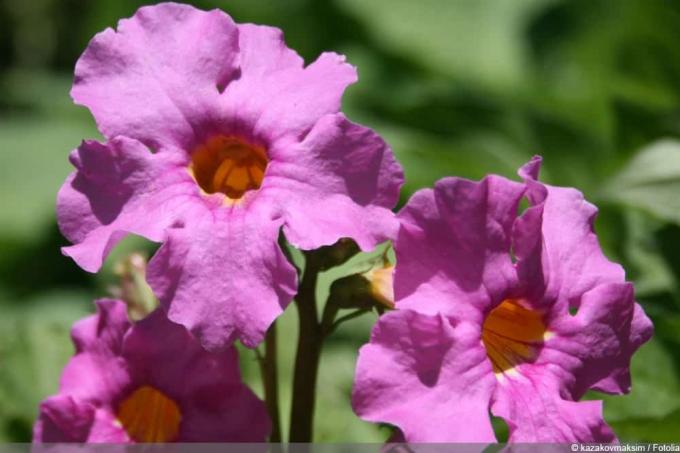
Flowering Fern: 14 Annual and Hardy Species | Care Instructions
A green fern with its beautifully designed fronds is a feast for the eyes in itself. It doesn't have to bloom to inspire. If flowers do appear, a garden gloxinia is actually at work. This flower is often incorrectly referred to as a blooming fern.
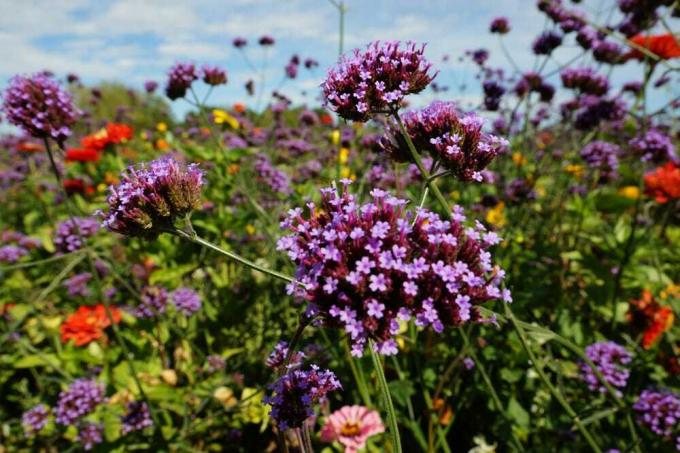
Patagonian Verbena, Verbena Bonariensis - Care Guide
Summer, sun, garden, flowers - here the Patagonian verbena is in its element, with fairy-like lightness purple flowers float on filigree stems above the flower bed and also attract all the butterflies area. Romantic gardeners love the effect of Verbena bonariensis, every gardener loves it Vigorous growth with the lowest maintenance requirements - verbena is a herb that benefits every garden brings.

